Getting Started with the Best Exercises for Desk Workers
In this article, we will uncover the best exercises for desk workers that can transform your workday and boost both health and productivity.
Did you know that prolonged sitting can be as harmful as smoking? This startling fact has been making the rounds in health circles, emphasizing the severe negative effects of a sedentary lifestyle. For desk workers, this is especially concerning as they spend a significant portion of their day seated. The consequences of long hours at a desk include poor posture, back pain, neck stiffness, and a higher risk of cardiovascular diseases. To combat these issues, incorporating exercises into your daily routine is essential.
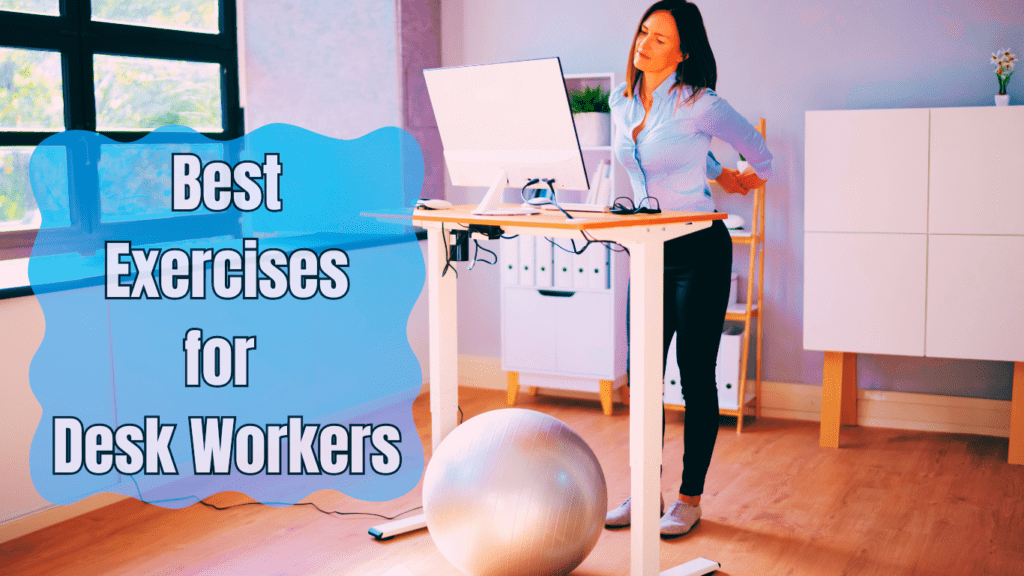
Why Desk Workers Need to Exercise
Desk jobs often mean sitting for extended periods, leading to a variety of health problems. When you sit for too long, your muscles become inactive, your metabolism slows down, and your posture deteriorates. This can result in muscle stiffness, joint pain, and reduced flexibility. Moreover, being inactive can lead to weight gain, increased blood pressure, and higher cholesterol levels, all of which contribute to more severe health conditions over time.
Preview of the Article
In this article, we will explore the best exercises for desk workers, designed to mitigate the adverse effects of prolonged sitting. We’ll look at simple yet effective exercises that can be easily incorporated into your daily routine, whether you’re at home or in the office. These exercises are tailored to improve posture, increase flexibility, and promote overall well-being. By the end of this article, you’ll have a comprehensive understanding of how to stay active and healthy, even with a demanding desk job.
The Impact of Prolonged Sitting on Health
Prolonged sitting has been linked to numerous health issues. One of the most significant problems is the development of musculoskeletal disorders. Sitting for long periods can lead to poor posture, which in turn can cause chronic back pain, neck pain, and even headaches. Additionally, staying seated for too long can contribute to the weakening of the core muscles, further exacerbating these issues.
Beyond musculoskeletal problems, prolonged sitting is associated with metabolic syndrome. This includes conditions such as increased blood pressure, high blood sugar levels, excess body fat around the waist, and abnormal cholesterol levels. These factors collectively increase the risk of heart disease, stroke, and diabetes. Regular physical activity is essential to counteract these effects and maintain metabolic health.
Subscribe And Get Our Free E-Book:Unlocking The Power Of Nutrition-Supplements, Substitutes, and Superfoods!
Mental Health Considerations
The impact of a sedentary lifestyle extends beyond physical health. Mental health can also suffer as a result of prolonged sitting. Physical inactivity has been linked to higher levels of stress, anxiety, and depression. Regular exercise releases endorphins, the body’s natural mood lifters, and helps reduce the levels of stress hormones like cortisol. Incorporating exercises into your routine can thus have a significant positive effect on mental well-being, improving mood, reducing stress, and enhancing overall quality of life.
Setting Realistic Goals
One of the challenges desk workers face is finding the time and motivation to exercise regularly. Setting realistic and achievable goals is crucial. Start by identifying short breaks during your workday where you can incorporate some physical activity. Even a few minutes of exercise every hour can make a substantial difference. It’s also helpful to choose exercises that you enjoy, as this increases the likelihood of sticking with your routine in the long run.
The Impact of Sedentary Work
For desk workers, the negative impacts of prolonged sitting can be severe, affecting both physical and mental health. Understanding these effects is crucial for appreciating the importance of incorporating the best exercises for desk workers into daily routines.
Physical Effects
Long periods of sitting can lead to several health issues, with back pain being one of the most common complaints among desk workers. When we sit for extended periods, especially with poor posture, the natural curve of the spine can be compromised. This misalignment causes stress on the spinal discs and muscles, leading to chronic back pain and discomfort. Additionally, sitting for too long can weaken the muscles in the back and core, exacerbating the problem and making it harder to maintain good posture.
Poor posture is another significant physical effect of sedentary work. When seated for long hours, many people tend to slouch or hunch over their desks, leading to a forward head posture and rounded shoulders. This not only looks unattractive but also strains the neck and upper back muscles. Over time, poor posture can lead to conditions like thoracic kyphosis (an exaggerated outward curve of the upper back) and cervical lordosis (an inward curve of the neck that becomes too pronounced).
Beyond musculoskeletal issues, prolonged sitting is associated with an increased risk of chronic diseases. Studies have shown that sitting for long periods can lead to metabolic syndrome, characterized by a cluster of conditions such as increased blood pressure, high blood sugar, excess abdominal fat, and abnormal cholesterol levels. These factors significantly raise the risk of heart disease, stroke, and type 2 diabetes. Regular physical activity is essential to counteract these risks and maintain overall health.
Mental Effects
The impact of a sedentary lifestyle extends beyond physical health, affecting mental well-being as well. Stress is a common issue among desk workers, and prolonged sitting can exacerbate this problem. Physical inactivity reduces the production of endorphins, the body’s natural mood enhancers, and increases the levels of stress hormones like cortisol. This imbalance can lead to heightened stress levels, anxiety, and even depression.
Reduced productivity is another mental effect of sedentary work. Sitting for long periods can cause mental fatigue, reducing focus and concentration. Physical activity is known to boost brain function, improve memory, and enhance cognitive abilities. When desk workers incorporate regular exercise into their routines, they often find that their productivity increases, and they can focus better on their tasks.
Expert Opinions
Health professionals and researchers have extensively studied the effects of prolonged sitting and advocate for the integration of regular physical activity into daily routines. According to Dr. James Levine, a prominent researcher at the Mayo Clinic, “Sitting is the new smoking.” He emphasizes that just as smoking was once considered a harmless habit but is now known to be deadly, sitting too much is emerging as a significant public health threat.
A study published in the British Journal of Sports Medicine highlights that even if individuals meet the recommended daily physical activity guidelines, sitting for prolonged periods still poses health risks. The study’s lead author, Dr. Emmanuel Stamatakis, notes, “Our findings suggest that reducing the total amount of daily sitting may be as important as increasing physical activity.” This underscores the importance of integrating movement throughout the day, not just during designated exercise times.
The American Heart Association also warns about the dangers of prolonged sitting. According to their research, sedentary behavior is linked to a 147% increase in the risk of cardiovascular events, such as heart attacks and strokes. They recommend breaking up long periods of sitting with short bouts of activity to improve cardiovascular health and overall well-being.
Given these insights, it’s clear that addressing the negative impacts of sedentary work requires a proactive approach. Incorporating the best exercises for desk workers into your daily routine is essential for mitigating these risks. In the following sections, we will explore specific exercises that are easy to perform and highly effective in counteracting the effects of prolonged sitting.
The physical and mental effects of sedentary work are significant and cannot be ignored. Back pain, poor posture, and an increased risk of chronic diseases are just some of the physical issues associated with long periods of sitting. On the mental side, stress and reduced productivity are common among desk workers who do not incorporate enough physical activity into their routines. Expert opinions and research findings consistently highlight the importance of regular movement to combat these negative effects. By understanding these impacts, desk workers can take proactive steps to improve their health and well-being. In the next part of this article, we will delve into the best exercises for desk workers, providing practical solutions to enhance your daily routine and counteract the adverse effects of prolonged sitting.
Best Exercises for Desk Workers: Try These Moves Now
When it comes to selecting the best exercises for desk workers, there are several key criteria to consider. These exercises should be simple to perform, require minimal space, and not need any special equipment. Additionally, they should be effective in counteracting the negative effects of prolonged sitting and improving overall well-being. With these criteria in mind, let’s explore a selection of exercises that can easily be incorporated into a desk worker’s daily routine.
Criteria for Selection
The best exercises for desk workers are those that can be done in a small space, such as an office cubicle or home workspace. These exercises should not require any special equipment, allowing workers to perform them without needing to leave their desks or disrupt their workflow. Moreover, these exercises should target areas that are commonly affected by prolonged sitting, such as the back, neck, shoulders, and wrists. They should also be simple enough to be done in a few minutes, making it easier for desk workers to integrate them into short breaks throughout the day.
Warm-up Routine
Before diving into the specific exercises, it’s essential to start with a simple warm-up routine. Warming up helps to prepare the muscles and joints for movement, reducing the risk of injury and making the exercises more effective. Here is a quick and easy warm-up routine that can be done right at your desk:
Seated Marching: Sit up straight and lift your knees one at a time as if you are marching. Do this for about one minute to get your blood flowing and your muscles activated.
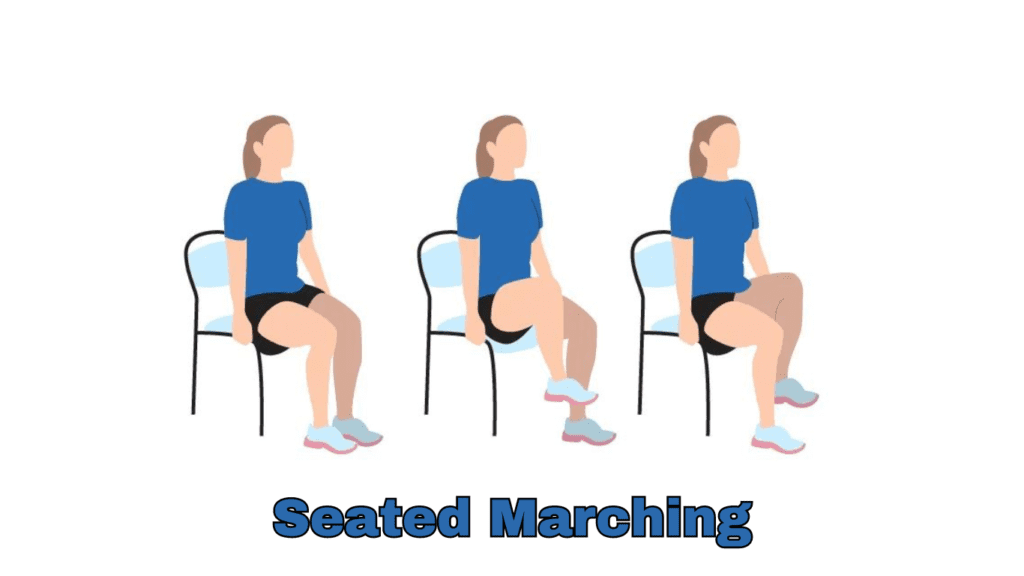
Arm Circles: Extend your arms out to the sides and make small circles with your hands. Gradually increase the size of the circles. Do this for 30 seconds in one direction and then switch to the opposite direction.
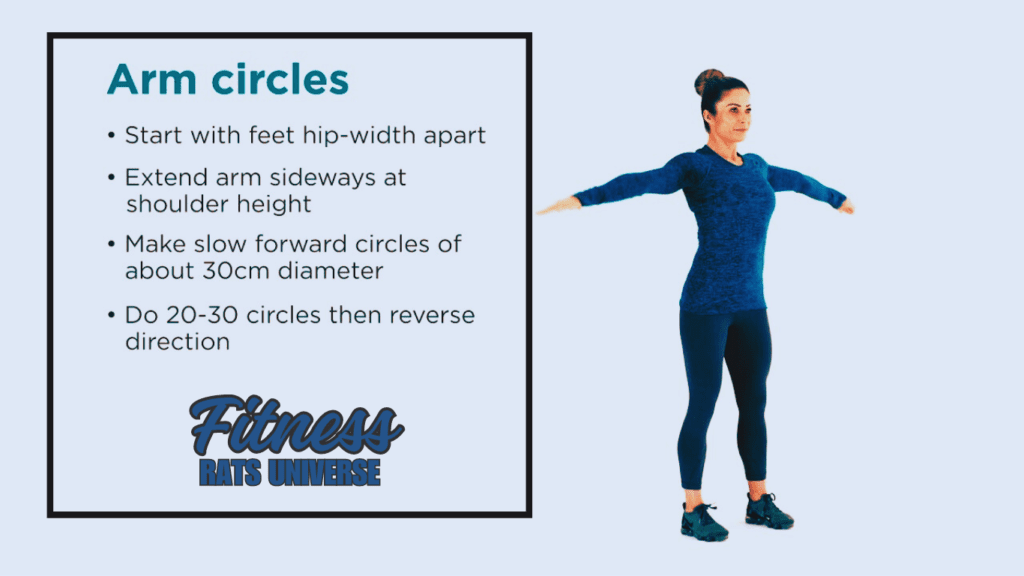
3. Shoulder Shrugs: Lift your shoulders up towards your ears and then release them back down. Repeat this movement for 30 seconds to loosen up the shoulder muscles.
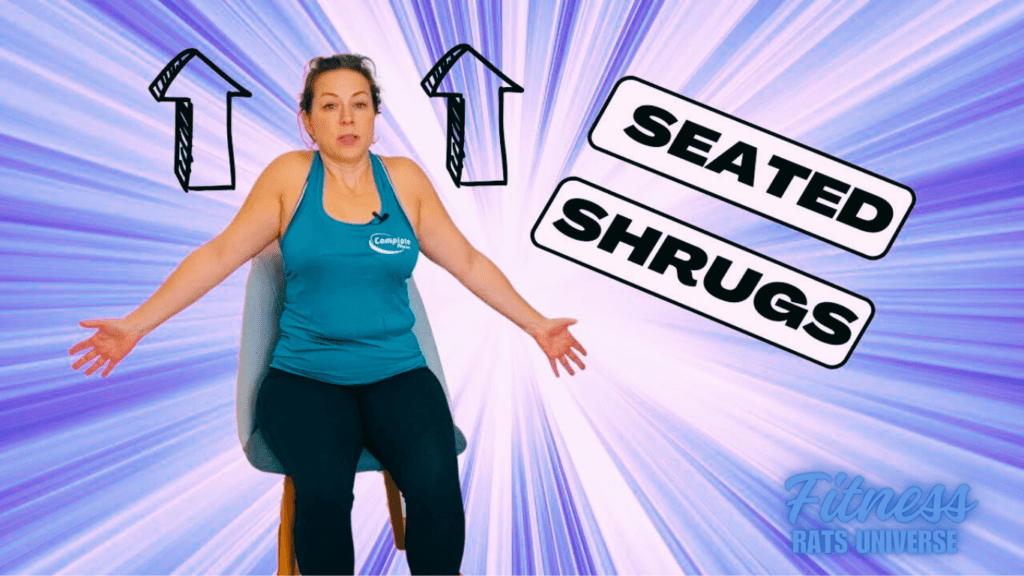
These warm-up exercises are quick and effective, setting the stage for the main desk exercises that follow.
Workday Wellness Schedule: Active Breaks for Desk Workers
| Time Interval | Suggested Activity | Duration | Benefits |
|---|---|---|---|
| Every 30 Minutes | Quick Stretch or Walk | 2-3 Minutes | Relieves muscle stiffness, improves circulation. |
| Hourly | Desk Exercises (e.g., Shoulder Rolls, Neck Stretches) | 5 Minutes | Reduces tension in the neck, shoulders, and back. |
| Mid-Morning & Mid-Afternoon | Standing or Walking Meeting | 10-15 Minutes | Enhances productivity, reduces fatigue, and boosts creativity. |
| Lunch Break | Brisk Walk or Light Exercise | 20-30 Minutes | Supports cardiovascular health, reduces stress. |
| End of Workday | Full-Body Stretching Routine | 10 Minutes | Improves flexibility, relaxes muscles, and reduces the risk of injury. |
How This Chart Complements the Article:
- Visual Guidance: The chart provides a clear, easy-to-follow schedule that readers can adopt, making the article’s advice more actionable.
- New Information: It introduces the concept of structured breaks, highlighting specific activities and their benefits, which complements the article’s discussion on the importance of regular movement.
- Increased Engagement: By offering a practical tool, readers are more likely to engage with the content and implement the suggested exercises in their daily routine.
Demonstrating the Best Exercises for Desk Workers
Now that you are warmed up, let’s move on to some specific exercises that are particularly beneficial for desk workers. These exercises are designed to be done right at your desk, targeting common problem areas and helping to improve posture and flexibility.
Shoulder Rolls
Shoulder rolls are excellent for relieving tension in the neck and shoulders, areas that often become stiff from long hours of sitting. To perform shoulder rolls, sit up straight with your feet flat on the floor. Lift your shoulders up towards your ears, then roll them back and down in a circular motion. Continue this movement for 10-15 seconds, then reverse the direction and roll your shoulders forward for another 10-15 seconds. This simple exercise helps to loosen up the shoulder muscles and improve circulation.
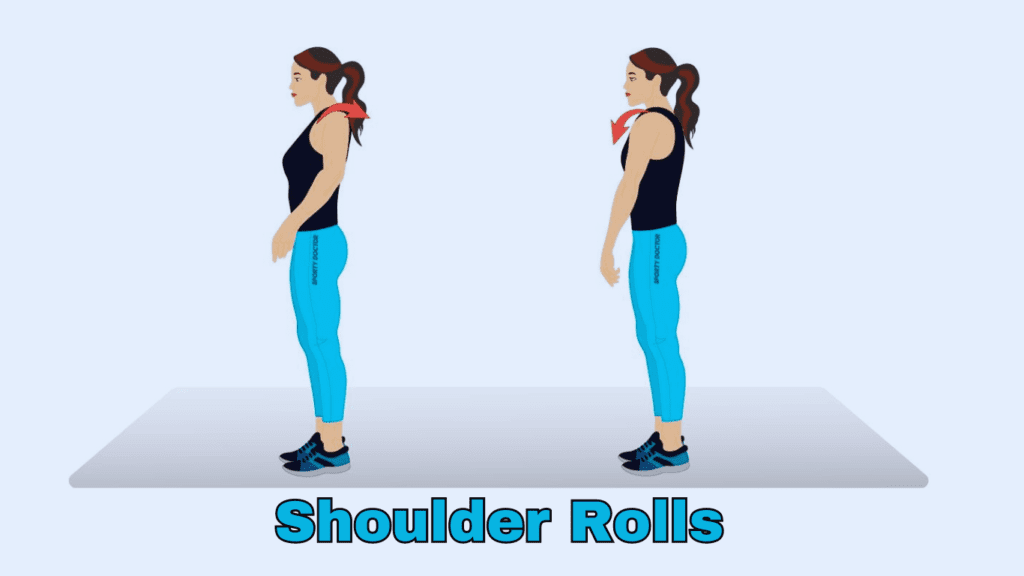
Neck Stretches
Neck stretches are crucial for desk workers who often experience neck stiffness and pain. Start by sitting up straight and gently tilting your head to the right, bringing your ear towards your shoulder. Hold this position for 10-15 seconds, feeling the stretch along the left side of your neck. Repeat on the other side. Next, tilt your head forward, bringing your chin towards your chest, and hold for 10-15 seconds. Finally, gently tilt your head back and hold for 10-15 seconds. These stretches help to relieve tension and improve flexibility in the neck muscles.

Wrist Circles
Wrist circles are important for desk workers who spend a lot of time typing and using a mouse, which can lead to wrist strain. To perform wrist circles, extend your arms in front of you with your palms facing down. Slowly rotate your wrists in a circular motion, making sure to move through the full range of motion. Do this for 10-15 seconds in one direction, then switch to the opposite direction. Wrist circles help to improve mobility and reduce the risk of repetitive strain injuries.
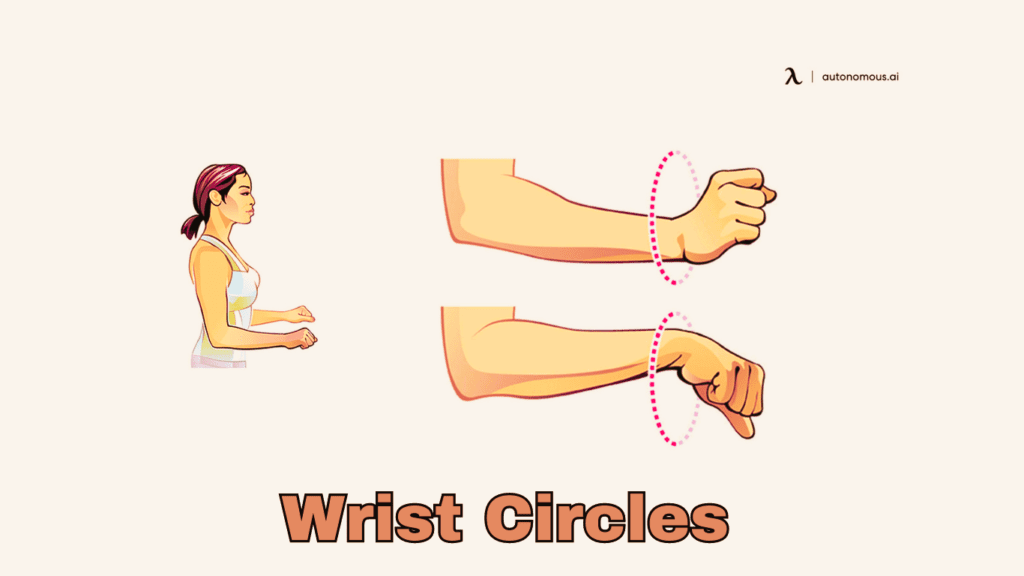
By incorporating these exercises into your daily routine, you can significantly reduce the negative impacts of prolonged sitting. Remember, the best exercises for desk workers are those that are easy to perform, require minimal space, and effectively target common problem areas. Taking short breaks throughout the day to perform these exercises can make a substantial difference in your overall health and well-being.
Desk workers face unique challenges due to the sedentary nature of their work. However, by understanding the criteria for selecting suitable exercises and incorporating a simple warm-up routine, they can effectively mitigate these challenges. The shoulder rolls, neck stretches, and wrist circles described above are just a few examples of the best exercises for desk workers. These exercises are designed to be quick, easy, and highly effective, helping to improve posture, reduce muscle tension, and enhance overall flexibility. By making these exercises a regular part of your workday, you can maintain better physical and mental health, even in a desk-bound job. Stay tuned for the next part of the article, where we will continue to explore more exercises and tips for desk workers.
Stretching Exercises
Stretching is an essential component of the best exercises for desk workers. It helps alleviate discomfort, improve flexibility, and maintain overall health. In this section, we will discuss various stretching exercises focusing on different parts of the body that are commonly affected by prolonged sitting. These include stretches for the neck and shoulders, lower back and hips, and legs and ankles. Each exercise is designed to be performed easily at your desk without the need for special equipment.
5 Easy Desk Stretches To Relieve Work Tension Video
Neck and Shoulders
The neck and shoulders are often the first areas to feel the strain of prolonged sitting. Here are some effective stretches to relieve tension and improve mobility in these areas:
Neck Tilts: Sit up straight in your chair with your shoulders relaxed. Slowly tilt your head to the right, bringing your ear toward your shoulder. Hold this position for 15-20 seconds, feeling the stretch along the left side of your neck. Return to the center and repeat on the left side. For an added stretch, gently place your right hand on the left side of your head and apply light pressure. Repeat on the other side.
Shoulder Stretches: Sit or stand with your back straight and shoulders relaxed. Bring your right arm across your body at chest height and use your left hand to gently pull your right arm closer to your chest. Hold for 15-20 seconds, then switch arms. This stretch targets the muscles around the shoulder and upper back, helping to relieve tension.
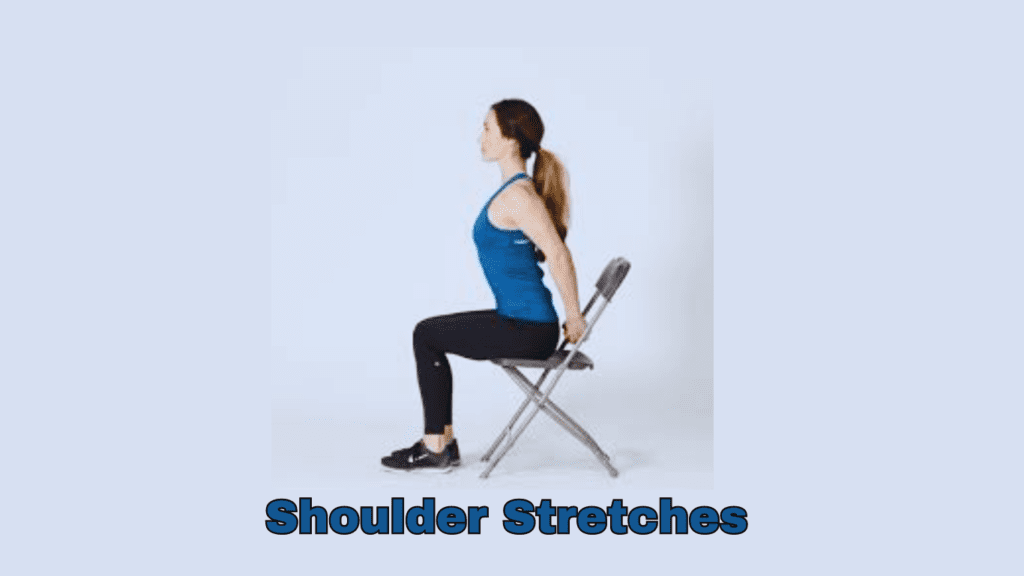
Upper Back Stretches: Sit or stand with your feet shoulder-width apart. Clasp your hands together and extend your arms straight out in front of you at shoulder height. Round your upper back and gently push your hands away from your body, feeling the stretch between your shoulder blades. Hold for 15-20 seconds. This stretch helps to alleviate tightness in the upper back and shoulders.
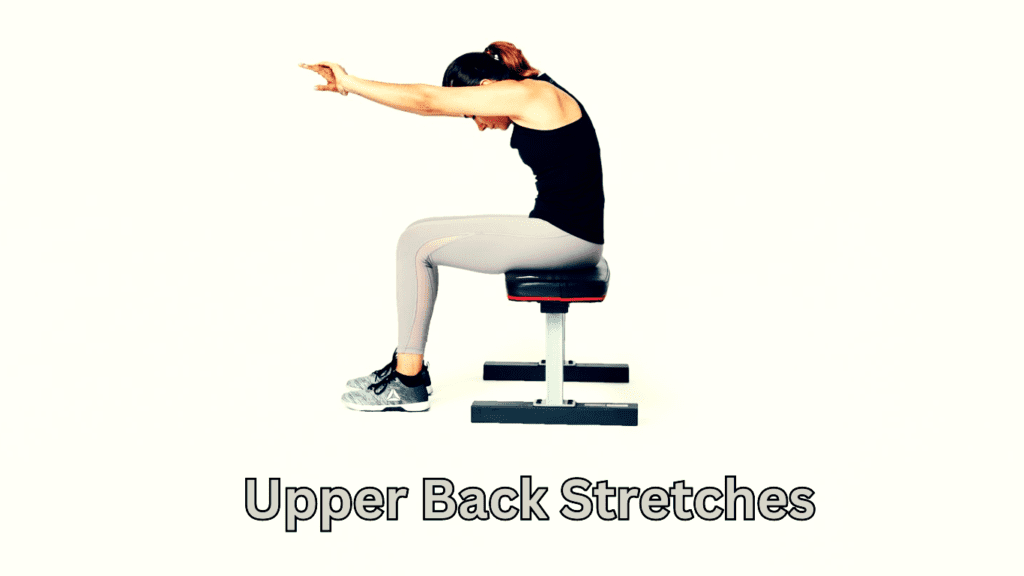
Lower Back and Hips
The lower back and hips often become tight and sore from sitting for long periods. The following stretches can help improve flexibility and reduce discomfort in these areas:
Seated Twists: Sit up straight in your chair with your feet flat on the floor. Place your right hand on the back of the chair and your left hand on your right knee. Gently twist your torso to the right, looking over your right shoulder. Hold for 15-20 seconds, then repeat on the left side. This stretch helps to improve spinal mobility and relieve lower back tension.

Hip Flexor Stretches: Stand up and place your right foot on your chair with your knee bent at a 90-degree angle. Keep your left leg straight and your hands on your hips. Gently push your hips forward until you feel a stretch in the front of your left hip. Hold for 15-20 seconds, then switch legs. This stretch targets the hip flexors, which can become tight from prolonged sitting.
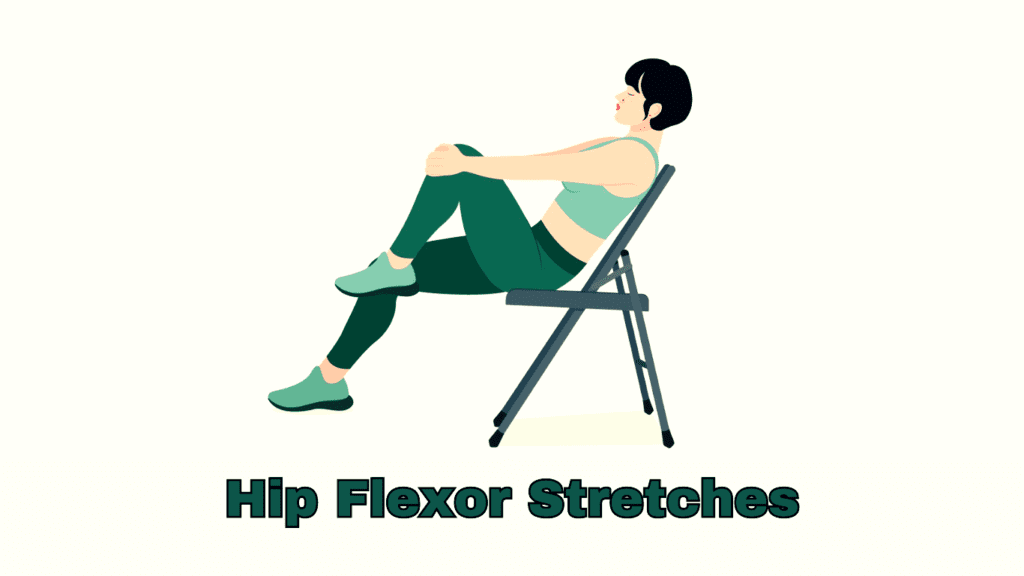
Hamstring Stretches: Sit on the edge of your chair with one leg extended straight out in front of you, heel on the floor and toes pointing up. Keep your back straight and gently lean forward from your hips until you feel a stretch along the back of your extended leg. Hold for 15-20 seconds, then switch legs. This stretch helps to alleviate tightness in the hamstrings, which can contribute to lower back pain.
Legs and Ankles
Stretching the legs and ankles is important for maintaining circulation and preventing stiffness. Here are some simple stretches that can be performed at your desk:
Calf Raises: Stand behind your chair and hold onto it for support. Slowly rise up onto the balls of your feet, lifting your heels off the ground. Hold for a few seconds, then lower your heels back down. Repeat 10-15 times. This exercise strengthens the calf muscles and improves circulation in the lower legs.
Ankle Circles: Sit up straight in your chair with your feet flat on the floor. Lift one foot off the ground and slowly rotate your ankle in a circular motion. Perform 10 circles in one direction, then switch to the opposite direction. Repeat with the other ankle. This stretch helps to improve ankle mobility and reduce stiffness.
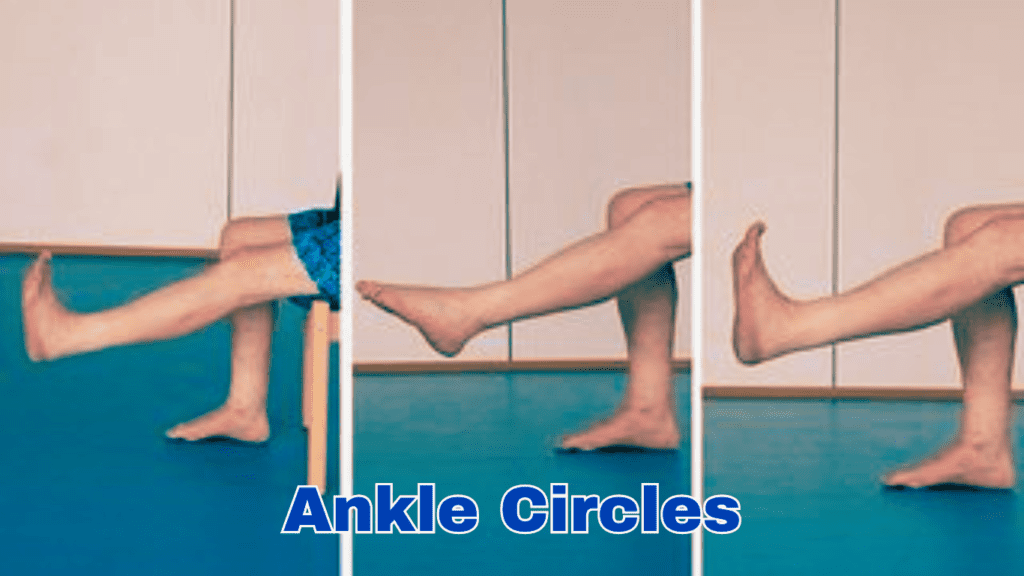
Seated Leg Extensions: Sit up straight in your chair with your feet flat on the floor. Extend one leg out in front of you until it is parallel to the floor, keeping your foot flexed. Hold for a few seconds, then lower your leg back down. Repeat 10-15 times on each leg. This exercise helps to strengthen the quadriceps and improve leg flexibility.
By incorporating these stretching exercises into your daily routine, you can significantly reduce the negative impacts of prolonged sitting. The best exercises for desk workers are those that are easy to perform, require minimal space, and effectively target common problem areas. Regular stretching helps to improve posture, reduce muscle tension, and enhance overall flexibility. Remember to take short breaks throughout the day to perform these exercises and maintain your physical well-being.
Desk workers face unique challenges due to the sedentary nature of their work. However, by understanding the importance of stretching and incorporating specific exercises for the neck and shoulders, lower back and hips, and legs and ankles, they can effectively mitigate these challenges. The detailed instructions provided for each stretch ensure that you can easily integrate these exercises into your daily routine. The best exercises for desk workers are those that are quick, simple, and highly effective, helping to maintain better physical and mental health even in a desk-bound job. Stay tuned for the next part of the article, where we will continue to explore more exercises and tips for desk workers.
Strengthening Exercises
Strengthening exercises are a vital component of the best exercises for desk workers, helping to build muscle, improve posture, and prevent injuries. Strength training can be easily integrated into your daily routine without the need for specialized equipment. This section will cover strengthening exercises focusing on the core, upper body, and lower body.
Core
A strong core is essential for maintaining good posture and preventing back pain, which is common among desk workers. Here are some effective core exercises that can be done at your desk:
Seated Marches: Sit up straight in your chair with your feet flat on the floor. Lift your right knee towards your chest as high as you can while engaging your core muscles. Lower your right foot back to the floor and repeat with your left knee. Continue alternating for 20-30 repetitions. This exercise helps to strengthen the lower abdominal muscles and improve overall core stability.
Desk Planks: To perform a desk plank, stand facing your desk and place your forearms on the desk with your elbows directly under your shoulders. Step back until your body forms a straight line from your head to your heels. Hold this position for 20-30 seconds, ensuring that you engage your core muscles and avoid letting your hips sag. Desk planks are an excellent way to strengthen the entire core without needing to get on the floor.
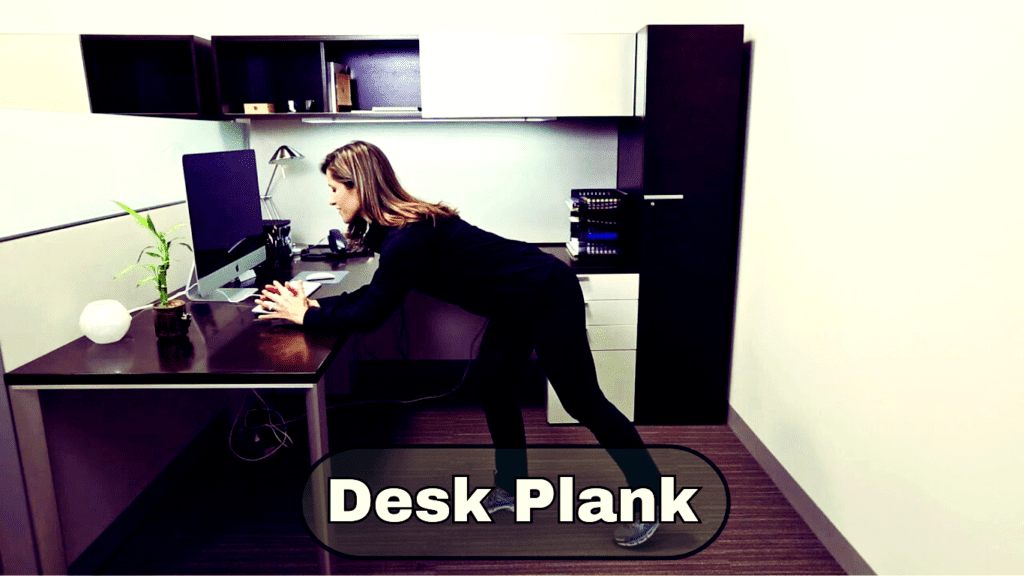
Seated Bicycle Crunches: Sit up straight in your chair with your feet flat on the floor. Place your hands behind your head and lift your right knee towards your chest while simultaneously twisting your torso to bring your left elbow towards your right knee. Return to the starting position and repeat on the opposite side. Continue alternating for 20-30 repetitions. This exercise targets the oblique muscles and helps to enhance overall core strength.
Upper Body
Strengthening the upper body is crucial for desk workers, as it helps to combat the effects of poor posture and shoulder tension. The following exercises can be performed using your chair and desk:
Chair Dips: Sit on the edge of your chair with your hands gripping the front edge. Slide your hips off the chair, supporting your weight with your hands and feet. Bend your elbows to lower your body towards the floor, then straighten your arms to push yourself back up. Repeat for 10-15 repetitions. Chair dips effectively target the triceps, shoulders, and chest muscles.
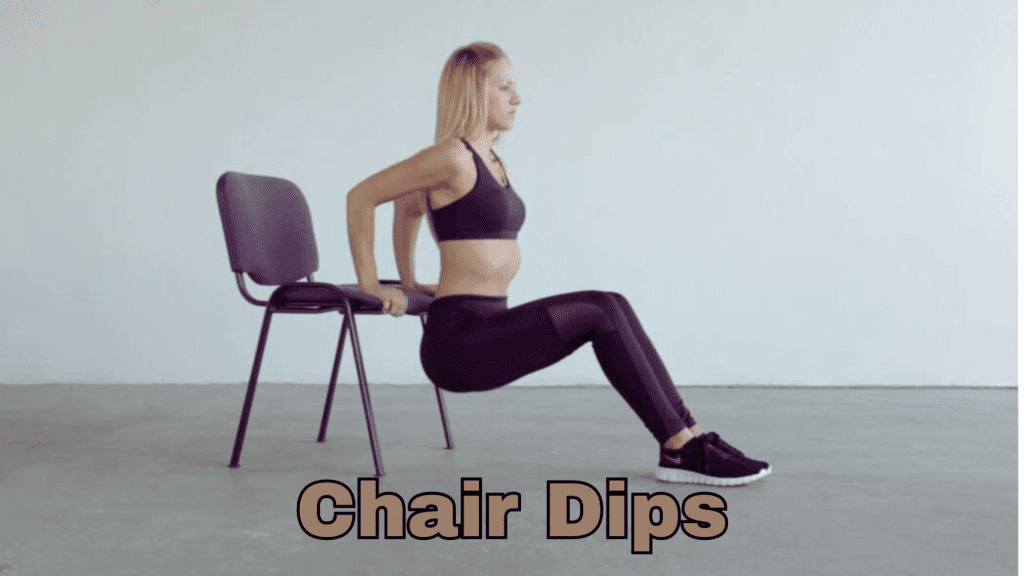
Desk Push-Ups: Stand facing your desk and place your hands on the edge, slightly wider than shoulder-width apart. Step back until your body forms a straight line from your head to your heels. Lower your chest towards the desk by bending your elbows, then push yourself back up to the starting position. Perform 10-15 repetitions. Desk push-ups are a great way to strengthen the chest, shoulders, and triceps.
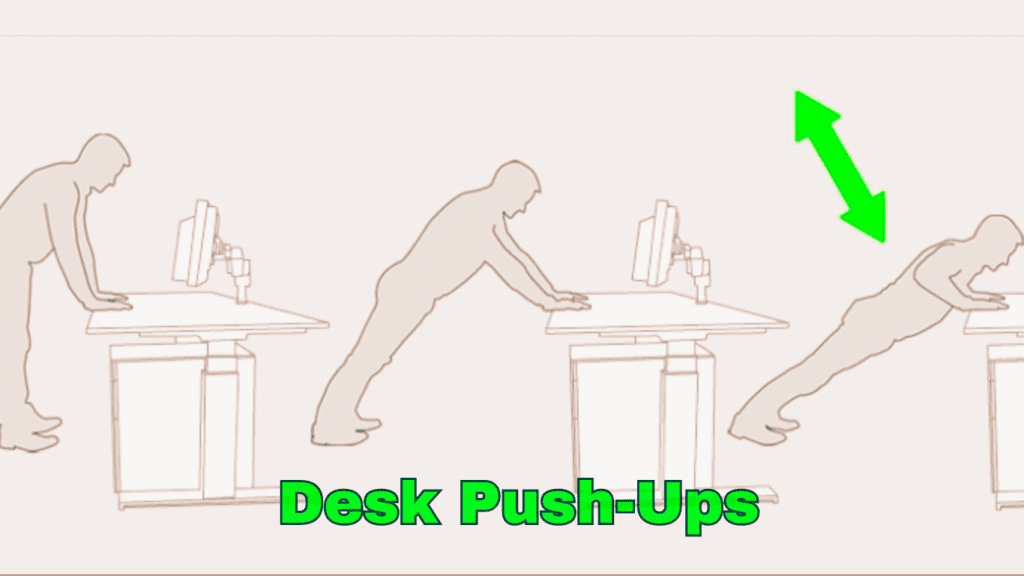
Seated Bicep Curls: Sit up straight in your chair with a water bottle in each hand, arms extended down by your sides. Slowly curl the bottles towards your shoulders, keeping your elbows close to your body. Lower the bottles back to the starting position. Repeat for 10-15 repetitions. This exercise targets the biceps and can be easily done with any small weights you have at hand.
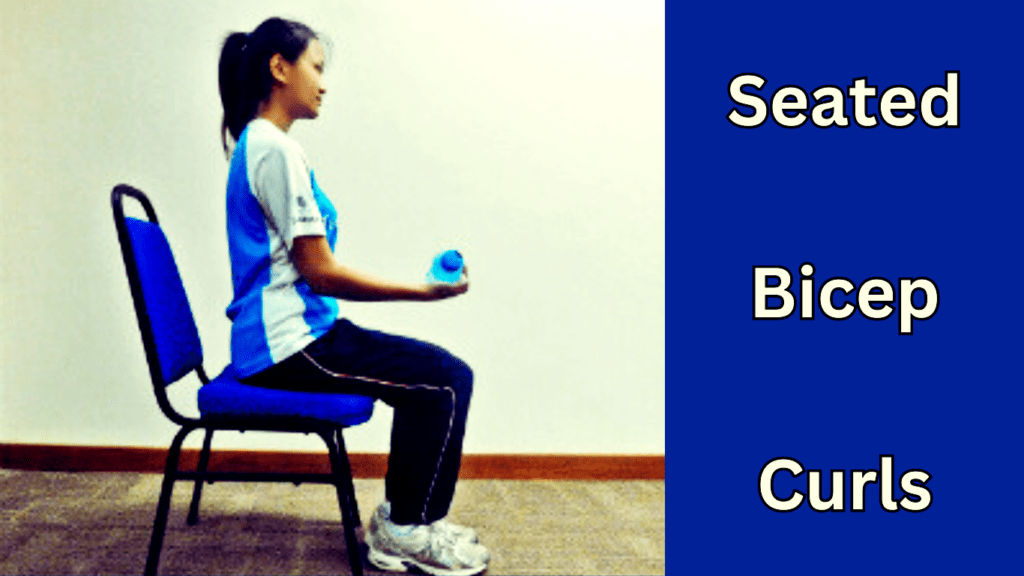
Lower Body
Strengthening the lower body is essential for maintaining overall mobility and preventing leg and hip discomfort. These exercises can be performed right at your desk:
Seated Leg Lifts: Sit up straight in your chair with your feet flat on the floor. Extend your right leg out in front of you, keeping it straight and parallel to the floor. Hold for a few seconds, then lower it back down. Repeat for 10-15 repetitions, then switch to the left leg. Seated leg lifts help to strengthen the quadriceps and improve leg flexibility.
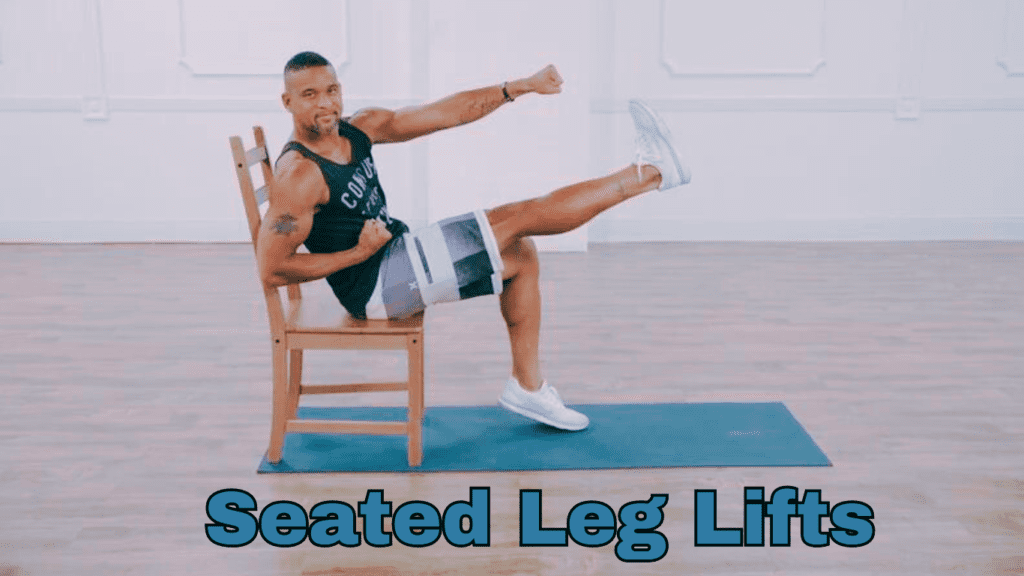
Standing Calf Raises: Stand behind your chair and hold onto it for support. Slowly rise up onto the balls of your feet, lifting your heels off the ground. Hold for a few seconds, then lower your heels back down. Repeat for 10-15 repetitions. Calf raises strengthen the calf muscles and improve circulation in the lower legs.
Wall Sits: Stand with your back against a wall and slide down until your knees are bent at a 90-degree angle, as if you are sitting in an invisible chair. Hold this position for 20-30 seconds, making sure to keep your back flat against the wall and your knees aligned with your ankles. Wall sits are excellent for strengthening the quadriceps, hamstrings, and glutes.
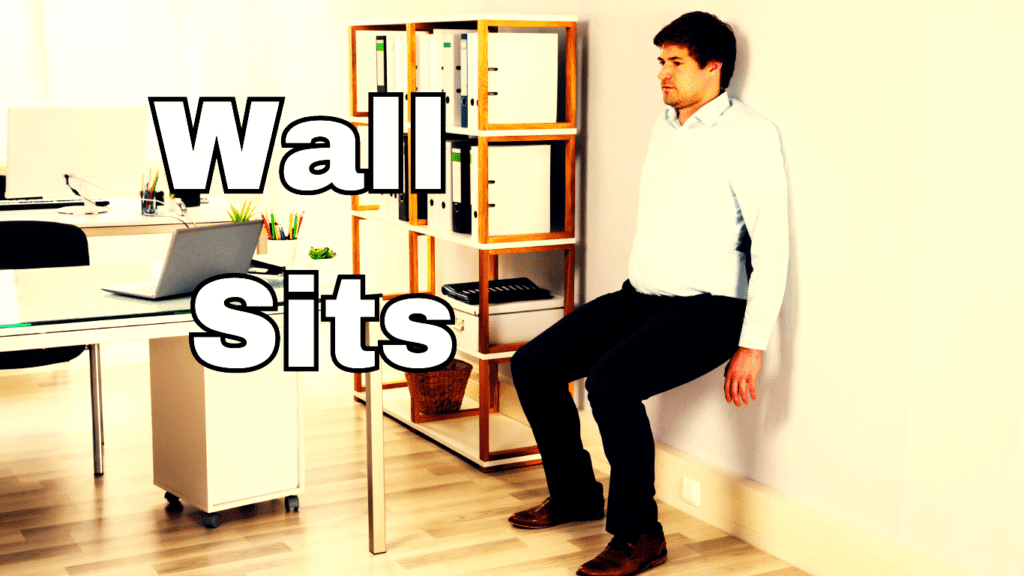
By incorporating these strengthening exercises into your daily routine, you can significantly improve your muscle tone and overall physical health. The best exercises for desk workers are those that are easy to perform, require minimal space, and target multiple muscle groups effectively. Regular strength training helps to improve posture, reduce muscle tension, and enhance overall strength and endurance.
Desk workers face unique challenges due to the sedentary nature of their work. However, by understanding the importance of strength training and incorporating specific exercises for the core, upper body, and lower body, they can effectively mitigate these challenges. The detailed instructions provided for each exercise ensure that you can easily integrate these activities into your daily routine. The best exercises for desk workers are those that are quick, simple, and highly effective, helping to maintain better physical and mental health even in a desk-bound job. Stay tuned for the next part of the article, where we will continue to explore more exercises and tips for desk workers.
Incorporating Movement into Your Day: Best Exercises for Desk Workers
For desk workers, integrating movement into the daily routine is crucial for maintaining physical health and mental well-being. The best exercises for desk workers are those that are easy to perform, can be done in short intervals, and help break up long periods of sitting. This section will discuss the importance of micro-breaks, the benefits of standing desks, and the idea of walking meetings.
Micro-breaks
Taking micro-breaks throughout the day is essential for desk workers. Prolonged sitting can lead to various health issues, including back pain, poor posture, and decreased productivity. By incorporating short breaks every hour, you can significantly reduce these negative effects. Here are some quick exercises that can be done during these breaks:
Seated Stretches: During your micro-break, take a moment to stretch while sitting at your desk. Simple stretches, such as reaching your arms overhead, stretching your legs under the desk, or rotating your neck, can help alleviate tension and improve circulation.
Desk Push-Ups: Stand up and place your hands on the edge of your desk. Step back and perform a few push-ups against the desk. This exercise targets the upper body and engages the core muscles, providing a quick boost of energy.
Walk Around: Stand up and take a brief walk around your office or home. Even a minute or two of walking can help increase blood flow and reduce stiffness in your muscles.
Standing Desks
Another effective way to incorporate movement into your day is by using a standing desk. Alternating between sitting and standing throughout the day can have numerous health benefits, making it one of the best exercises for desk workers. Here’s why standing desks are beneficial and how to use them effectively:
Improved Posture: Standing desks encourage better posture by promoting a natural alignment of the spine. When you stand, you are more likely to engage your core muscles and maintain an upright position, reducing the risk of back pain and improving overall posture.
Increased Energy Levels: Standing periodically can help combat the mid-afternoon slump. When you stand, your body is more active, which can lead to increased energy levels and improved concentration.
Reduced Risk of Chronic Diseases: Studies have shown that alternating between sitting and standing can help lower the risk of chronic diseases such as obesity, diabetes, and cardiovascular issues. Standing for even part of the day can have a positive impact on your overall health.
To effectively use a standing desk, start by alternating between sitting and standing every 30 to 60 minutes. Ensure your desk and computer monitor are at the correct height to maintain proper posture. Use an anti-fatigue mat to reduce strain on your feet and legs while standing.
Walking Meetings
Incorporating walking meetings into your routine is another excellent way to add movement to your day. Instead of sitting in a conference room or at your desk for meetings, consider taking your discussions on the go. Walking meetings offer several benefits for desk workers:
Boosted Creativity: Walking can stimulate creative thinking and problem-solving. The change of scenery and movement can help generate new ideas and perspectives.
Improved Physical Health: Walking meetings provide an opportunity to get some exercise during the workday. Even a short walk can contribute to your daily physical activity goals and improve cardiovascular health.
Enhanced Collaboration: Walking side by side with colleagues can foster a more relaxed and open environment, encouraging more candid and productive conversations.
To incorporate walking meetings into your day, suggest the idea to your colleagues or team members. Plan routes that are safe and convenient, whether around your office building or in a nearby park. If walking meetings are not feasible, consider taking phone calls while walking to add some movement to your routine.
In conclusion, desk workers can greatly benefit from incorporating movement into their daily routines. The best exercises for desk workers are those that are simple, quick, and effective in breaking up long periods of sitting. Taking micro-breaks, using a standing desk, and incorporating walking meetings are all excellent strategies to enhance physical health and mental well-being. By making these small changes, you can reduce the negative effects of a sedentary lifestyle and improve your overall productivity and energy levels.
Regularly integrating these practices into your workday can make a significant difference in your health. Micro-breaks provide a quick way to stretch and move, preventing stiffness and promoting circulation. Standing desks offer an alternative to sitting all day, helping to improve posture and reduce the risk of chronic diseases. Walking meetings not only provide physical activity but also encourage creativity and collaboration.
Remember, the key to success is consistency. Aim to incorporate these strategies into your daily routine and adjust as needed to find what works best for you. By prioritizing movement and making it a natural part of your workday, you can maintain better physical and mental health, even in a desk-bound job. Stay tuned for the next part of the article, where we will continue to explore more exercises and tips for desk workers.
Creating a Routine for Desk Workers
Developing a consistent exercise routine is a key component of the best exercises for desk workers. A structured approach not only helps to integrate physical activity into your daily life but also ensures that you reap the full benefits of movement. This section will cover how to create a daily schedule that incorporates exercise and breaks, set reminders to keep you on track, and maintain consistency to make exercise a lasting habit.
Desk Worker Exercise Frequency Guide Chart:
| Exercise Type | Specific Exercise | Recommended Frequency |
|---|---|---|
| Stretching | Neck Tilts | Every hour |
| Shoulder Stretches | Every hour | |
| Seated Twists | Every 2 hours | |
| Hamstring Stretches | Every 2 hours | |
| Strengthening | Seated Marches | 2-3 times daily |
| Desk Planks | 2-3 times daily | |
| Chair Dips | 2-3 times daily | |
| Seated Bicep Curls | 2-3 times daily | |
| Movement Incorporation | Micro-Breaks | Every hour |
| Standing Desk Use | Alternate sitting/standing every 30-60 minutes | |
| Walking Meetings | As often as possible |
Daily Schedule
Establishing a well-rounded daily schedule is essential for effectively incorporating the best exercises for desk workers into your routine. Here’s a sample schedule that includes exercises, breaks, and periods of movement:
Morning Routine: Start your day with a quick stretch to wake up your body and prepare for the day ahead. Spend 5 minutes doing some simple stretches such as neck tilts, shoulder rolls, and upper back stretches. This helps to alleviate any stiffness and improves circulation.
Mid-Morning Break: After working for about 1-2 hours, take a 5-minute break. Use this time for a short walk around the office or perform some desk exercises like seated marches or desk push-ups. This helps to prevent stiffness and maintain energy levels.
Lunch Break: Use your lunch break as an opportunity for more extended movement. Consider going for a brisk 10-15 minute walk, or if time allows, incorporate some standing desk time during your meal. This helps to counteract the effects of prolonged sitting and boosts your overall physical activity.
Afternoon Break: After another 1-2 hours of work, take another 5-minute break. Use this time to perform a few stretching exercises, such as seated leg lifts or calf raises. This helps to refresh your body and mind, improving productivity and focus.
Evening Routine: At the end of your workday, consider doing a quick series of strengthening exercises, such as chair dips or seated bicycle crunches. This not only helps to wind down from the day but also ensures that you get a balanced mix of exercise throughout the day.
Setting Reminders
Staying consistent with the best exercises for desk workers can be challenging, especially when busy with work tasks. Setting reminders can help keep you on track and ensure you take regular breaks and incorporate movement into your day. Here are a few suggestions:
Use Apps: Several apps are designed to remind you to move, stretch, or exercise at regular intervals. Apps like Stretchly or Stand Up! can send notifications to prompt you to take breaks and perform exercises.
Set Alarms: If you prefer a simpler approach, set alarms on your phone or computer to remind you to take breaks. For example, set an alarm every hour to prompt you to perform a quick stretch or take a short walk.
Calendar Alerts: You can also schedule regular exercise and movement breaks into your calendar. Treat them as important appointments that you cannot miss. This can help establish a routine and ensure that you consistently incorporate physical activity into your day.
Staying Consistent
Consistency is key to making the best exercises for desk workers a lasting part of your daily routine. Here are some tips to help you stay motivated and make exercise a habit:
Set Realistic Goals: Start with small, achievable goals and gradually increase the intensity and duration of your exercises. For example, begin with 5-minute breaks and stretches, then work your way up to longer exercise sessions.
Create a Routine: Incorporate exercise and movement into your daily schedule at specific times. By creating a routine, you make it easier to remember and stick to your exercise goals.
Track Your Progress: Keep a journal or use an app to track your exercise and movement throughout the day. Seeing your progress can provide motivation and help you stay on track with your goals.
Find a Workout Buddy: If possible, find a colleague or friend to join you in your exercise routine. Having someone to share your goals with can make exercising more enjoyable and keep you accountable.
Mix It Up: To keep things interesting, vary your exercises and try new movements regularly. This prevents boredom and keeps you engaged in your routine. For example, alternate between stretching exercises, strengthening exercises, and walking meetings.
Reward Yourself: Set up a reward system for reaching your exercise goals. This could be something simple, like enjoying a favorite snack or taking some extra relaxation time. Rewards can help reinforce positive behavior and motivate you to continue.
Creating a routine that incorporates the best exercises for desk workers is crucial for maintaining physical and mental well-being. By establishing a daily schedule that includes regular exercise and movement, setting reminders to stay on track, and using strategies to maintain consistency, you can effectively integrate physical activity into your workday. Consistency and routine are key to making exercise a natural and rewarding part of your daily life. Stay committed to your routine, and you’ll reap the benefits of a healthier, more active lifestyle even while working at a desk.
Wrapping Up: Final Tips and Encouragement on the Best Exercises for Desk Workers
Congratulations on reaching the end of this guide on the best exercises for desk workers! You’ve learned a lot about how to integrate movement into your workday, and now it’s time to turn that knowledge into action. Let’s recap the essential takeaways and inspire you to start incorporating these practices into your daily routine.
The Importance of Movement
Sitting for long periods can take a significant toll on your body and mind. It’s crucial to recognize the need for regular movement to counteract the effects of prolonged sitting. The best exercises for desk workers, whether they involve stretching, strengthening, or incorporating micro-breaks, are designed to improve posture, enhance productivity, and promote overall well-being. By understanding the impact of a sedentary lifestyle and incorporating movement, you are taking an important step towards better health.
Taking Action
Now that you’re equipped with knowledge about effective exercises and movement strategies, it’s time to implement them. Begin by creating a daily routine that includes the best exercises for desk workers. Set specific times for short breaks, stretching, and strengthening exercises. Don’t wait for the perfect moment—start small, with just a few minutes of movement each day, and gradually build from there. Consistency is key, and every little bit of effort counts towards a healthier workday.
Optimizing Your Workspace
To make the most of your exercise routine, consider setting up your desk space for better ergonomics. An ergonomically sound workspace not only prevents discomfort but also encourages more natural movement throughout the day. Invest in a chair that supports good posture, adjust your desk and monitor to the appropriate heights, and consider a standing desk if possible. This setup can complement your exercise routine by making it easier to incorporate movement seamlessly into your workday.
Taking the Next Steps
Today is the perfect day to start. Pick one of the best exercises for desk workers that you found interesting and try it out. Whether it’s a quick desk plank, a few seated leg lifts, or a brisk walk around the office, taking action now will set the tone for future success. Remember, the key is to start small and build gradually. Even small steps towards integrating movement into your day can lead to significant improvements in your health and productivity.
Further Reading and Resources
To deepen your understanding and continue your journey towards a more active lifestyle, consider exploring the following books and articles:
- “Deskbound: Standing Up to a Sitting World” by Dr. Kelly Starrett – This book offers insights into the impact of sitting and practical solutions for improving movement throughout the day.
- “The Deskbound Cure: How to Conquer the Sitting Disease” by Dr. Jonathan L. H. O’Sullivan – Provides strategies for overcoming the negative effects of prolonged sitting and improving overall health.
- Articles from the Journal of Occupational Health Psychology – Offers research-based insights into ergonomics, movement, and productivity.
Useful Tools and Apps
To help you stay on track with your movement goals, consider using the following tools and apps:
- Stretchly – A free app that reminds you to take breaks and perform stretches throughout your workday.
- Stand Up! – An app that prompts you to stand and move at regular intervals, helping you to incorporate more activity into your routine.
- MyFitnessPal – Useful for tracking your physical activity and setting fitness goals.
- Ergonomic Tools – Adjustable desks, ergonomic chairs, and monitor stands can help you create a more movement-friendly workspace.
Final Encouragement
Incorporating the best exercises for desk workers into your daily routine is not just about improving your physical health—it’s about enhancing your overall quality of life. By taking regular breaks, using ergonomic tools, and committing to a movement-friendly routine, you are making a proactive choice for your well-being. Remember, every small step you take towards integrating movement into your workday is a step towards a healthier, more productive life.
So go ahead, take that first step today. Incorporate a quick exercise, set up your workspace for better ergonomics, or simply remind yourself to take a break. The journey to better health and productivity starts with a single action, and you have the power to make that change. Embrace these practices and watch as they transform your workday, your health, and your life. You’ve got this!


